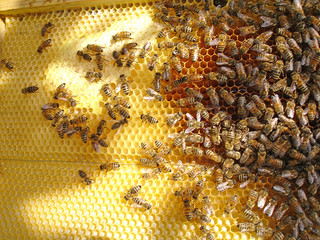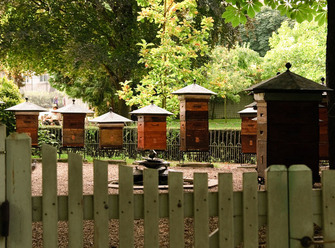« Prev Next »
 A swarm of studies have recently been released concerning Colony Collapse Disorder (CCD), and considering the serious implications of their findings, it's all of our beeswax. These experiments, including two published in Science1,2 and one forthcoming from the Bulletin of Insectology,3 demonstrate the threat to hive survival stemming from a class of insecticides called neonicotinoids. Individually, I think each study is convincing, but when taken together, the consensus provides overwhelming support as to the harms of neonicotinoids and their possible role in the rash of mysterious bee deaths that gave rise to the term CCD in late 2006.
A swarm of studies have recently been released concerning Colony Collapse Disorder (CCD), and considering the serious implications of their findings, it's all of our beeswax. These experiments, including two published in Science1,2 and one forthcoming from the Bulletin of Insectology,3 demonstrate the threat to hive survival stemming from a class of insecticides called neonicotinoids. Individually, I think each study is convincing, but when taken together, the consensus provides overwhelming support as to the harms of neonicotinoids and their possible role in the rash of mysterious bee deaths that gave rise to the term CCD in late 2006.
Honey farmers in North America and Europe began noticing in the 1990s and early 2000s that worker bees were leaving their hives to gather pollen, but were not returning, even when there was ample food stored in the comb.4 Abandoned hives were then being found, all with unhatched broods of young larvae, stored honey and pollen, and queen bees left deserted. Over the course of a few days or weeks, a beekeeper could watch a healthy colony's population of around 40,000 worker bees be reduced to hundreds, and then vanish.5 By 2007, when about a fourth of US beekeepers had reported these mysterious apiary epidemics and with similar outbreaks reported elsewhere, researchers were motivated to identify the cause.
Initially, scientists thought a microbe could be responsible, such as the Israeli acute paralysis virus,6 but certain recurrences did not align with this theory. Living queen bees and young broods were being abandoned, as mentioned, and the deaths seemed to follow a seasonal pattern, occurring in late winter to early spring. Also, rather than there being a density of dead bees in or around the hive, honeycombs were found almost completely empty. These features led researchers to wonder whether commercial pesticides, such as those with neonicotinoids, were involved in the bee demise.
Neonicotinoids are a class of neuro-active insecticides, which, similar to the nicotine in cigarettes, operate systemically as nicotinic acetylcholine receptor agonists. The first neonicotinoids were initially synthesized by a development division of the Shell Oil Company in the early 1970s, and they are now one of the most widely used insecticides in the world, due to their purported relative safety for mammals.7 Corn farmers in the early 2000s, for example, regularly began applying the neonicotinoids to their crop seedlings before planting, so that the chemical could circulate throughout plant tissues during their germination and growth.8
Environmental scientists at the Harvard School of Public Health in Boston began to wonder if this practice was responsible for CCD, as beekeepers often use high-fructose corn syrup to supplement bees' food sources during the winter, supporting the seasonal timing of CCD. To test the idea, they set up four independent apiaries, each consisting of a control hive and four different imidacloprid-exposed hives, with imidacloprid being a popular neonicotinoid.9 The imidacloprid-exposed bees were allowed to forage for pollen in the fields, but also had close access to a high fructose corn syrup feeder with varying levels of the insecticide. The researchers dosed the non-control syrup for 13 weeks, and after 23 weeks, 15 of 16 the imidacloprid-treated hives (~94%) were dead. These collapsed combs were also "remarkably empty" except for stores of honey and pollen, characteristic of CCD.
In a different yet related study, a second research team tried to locate the mechanism behind the CCD abandonment. This group from the French National Institute for Agricultural Research found that worker bees that were exposed to a neonicotinoid insecticide named thiamethoxam had difficulty flying back to the hive after setting out to forage.10 By gluing radio-frequency identification microchips to the bees' backs, researchers revealed that tagged bees that were exposed to low doses of thiamethoxam were two to three times more likely to die away from their hives, indicating that the chemical was interfering with their homing systems.
Furthermore, another group of scientists have published evidence that exposure alone can affect bee colony growth rates, in addition to their impact on individual navigation abilities. In a third investigation, researchers from the University of Stirling observed that bee colonies that were treated with imidacloprid in the lab had an 85% reduction in the production of new queens when compared with control groups once in the field.11 Although in each of these three experiments, the administration and dose of insecticide probably differed from that of typical apiary conditions, they certainly do show that these important pollinators are incredibly vulnerable to neonicotinoids.
 Anticipating these findings, many countries have already restricted or passed bans against the use of neonicotinoids, including France, Germany, and Italy, though it remains to be seen how the US EPA and other agencies will respond. Pesticide producers have not refuted the new studies directly, though Monsanto, a huge producer of pesticides and other kinds of agricultural biotechnology, did recently purchase Beelogics, a private bee research firm that views Israeli acute paralysis virus as the factor most strongly correlated with CCD.12
Anticipating these findings, many countries have already restricted or passed bans against the use of neonicotinoids, including France, Germany, and Italy, though it remains to be seen how the US EPA and other agencies will respond. Pesticide producers have not refuted the new studies directly, though Monsanto, a huge producer of pesticides and other kinds of agricultural biotechnology, did recently purchase Beelogics, a private bee research firm that views Israeli acute paralysis virus as the factor most strongly correlated with CCD.12
While, for me, these recent findings are all compelling, no matter CCD's cause, it seems to have attracted droves of novice beekeepers. In Paris, urban apiarists trying to take the sting out of the rural loss have been installing hives in parks and on the roofs of famous buildings and apartments.13 As the gardens of Paris have been pesticide-free for more than a decade, I bet honey bees are finding city life there to be pretty sweet.
Image credits: Photo of bees is by Flickr's net_efekt and photo of bee boxes in Paris' Jardin du Luxembourg is by Flickr's denovich.
1. Henry, M., Béguin, M., Requier, F., Rollin, O., Odoux, J.F., Aupinel, P., Aptel, J., Tchamitchian, S., & Decourtye, A. (2012). A common pesticide decreases foraging success and survival in honey bees. Science, 336, 348-350 PMID: 22461498. ResearchBlogging.com.2.Whitehorn, P.R., O'Connor, S., Wackers F.L., & Goulson, D. (2012). Neonicotinoid pesticide reduces bumble bee colony growth and queen production. Science, 336, 351-2 PMID: 22461500. ResearchBlogging.com.
3. Lu, C., Warchol, K., & Callahan, R. In situ replication of honey bee colony collapse disorder. Bulletin of Insectology, forthcoming in 2012.
4. Raloff, J. "Yet Another Study Links Insecticide to Bee Losses." Science News. April 5, 2012.
5. North American Pollinator Protection Campaign."Honey Bee Disappearance (CCD) and What You Can Do." NAPPC report, 2007.
6. Revkin, A. "Scientists See Suspect in Mass Deaths of Bees." New York Times. September 6, 2007.
7. Jeschke, P. and Nauen, R. "Neonicotinoid Insecticides." Insect Control: Biological and Synthetic Agents. Lawrence I. Gilbert, Sarjeet S. Gill. eds. London: Academic Press, 2010, 61-120.
8. Raloff.
9. Lu, et al.
10. Henry, et al.
11. Whitehorn, et al.
12. Schiffman, R. "The Fox (Monsanto) Buys the Chicken Coop (Beelogics)." Huffington Post. May 3, 2012.
13. Scholfield, H. "Paris Fast becoming Queen Bee of the Urban Apiary World." BBC Paris. August 14, 2010.






















